Study of Concrete under Combined Action of Aggressive Environment and Long-Term Loading
Abstract
1. Introduction and Literature Review
2. Materials and Methods
- (a)
- Only the central compressive force without aggressive medium,
- (b)
- Simultaneous influence of compressive force and aquatic medium,
- (c)
- Simultaneous influence of compressive force and aggressive environment.
- Series 5 contained 4 prisms, tested in the air, subjected to long-term loading.
- Series 6 contained 6 prisms, tested in the air, subjected to short-term loading.
- Series 7 contained 6 prisms, tested on shrinkage.
- Series 8 contained 4 prisms, tested in aquatic medium, subjected to long-term loading.
3. Results and Discussion
3.1. Experimental Testing of the Concrete Prisms in the Aggressive Medium
3.2. Study of the Microstructure and Mineral Composition of Concrete after Exposure to Aggressive Environment
4. Conclusions
Author Contributions
Funding
Institutional Review Board Statement
Informed Consent Statement
Data Availability Statement
Conflicts of Interest
References
- Kotes, P.; Strieska, M.; Brodnan, M. Sensitive analysis of calculation of corrosion rate according to standard approach. IOP Conf. Ser. Mater. Sci. Eng. 2018, 385, 012031. [Google Scholar] [CrossRef]
- Blikharskyy, Y.; Selejdak, J.; Kopiika, N. Corrosion Fatigue Damages of Rebars under Loading in Time. Materials 2021, 14, 3416. [Google Scholar] [CrossRef] [PubMed]
- Blikharskyy, Y.; Selejdak, J.; Bobalo, T.; Khmil, R.; Volynets, M. Influence of the percentage of reinforcement by unstressed rebar on the deformability of pre-stressed RC beams. Prod. Eng. Arch. 2021, 27, 212–216. [Google Scholar] [CrossRef]
- Bahleda, F.; Drevený, I.; Pitoňák, M.; Neslušan, M.; Koteš, P. Employment of Barkhausen Noise Technique for Assessment of Prestressing Bars Damage with Respect of Their Over-Stressing. Metals 2021, 11, 770. [Google Scholar] [CrossRef]
- Blikharskyy, Y.; Selejdak, J. Influence of the percentage of reinforcement damage on the bearing-capacity of RC beams. Constr. Optim. Energy Potential 2021, 10, 145–150. [Google Scholar] [CrossRef]
- Stewart, M.G.; Mullard, J.A. Spatial time-dependent reliability analysis of corrosion damage and the timing of first repair for RC structures. Eng. Struct. 2007, 29, 1457–1464. [Google Scholar] [CrossRef]
- Blikharskyy, Z.; Sobol, K.; Markiv, T.; Selejdak, J. Properties of Concretes Incorporating Recycling Waste and Corrosion Susceptibility of Reinforcing Steel Bars. Materials 2021, 14, 2638. [Google Scholar] [CrossRef]
- Dmitrović, L.G.; Kos, Ž.; Klimenko, Y. The development of prediction model for failure force of damaged reinforced-concrete slender columns. Teh. Vjesn. 2019, 26, 1635–1641. [Google Scholar] [CrossRef]
- Vatulia, G.L.; Lobiak, O.V.; Deryzemlia, S.V.; Verevicheva, M.A.; Orel, Y.F. Rationalization of cross-sections of the composite reinforced concrete span structure of bridges with a monolithic reinforced concrete roadway slab. IOP Conf. Ser. Mater. Sci. Eng. 2019, 664, 012014. [Google Scholar] [CrossRef]
- Selejdak, J.; Blikharskyy, Y.; Khmil, R.; Blikharskyy, Z. Crack Resistance RC Columns Strengthened by CFRP System. Key Eng. Mater. 2021, 878, 127–133. [Google Scholar] [CrossRef]
- Ulewicz, R.; Kleszcz, D.; Ulewicz, M. Implementation of Lean Instruments in Ceramics Industries. Manag. Syst. Prod. Eng. 2021, 29, 203–207. [Google Scholar] [CrossRef]
- Klimecka-Tatar, D.; Ingaldi, M. Assessment of the Technological Position of a Selected Enterprise in the Metallurgical Industry. Mater. Res. Proc. 2020, 17, 72–78. [Google Scholar] [CrossRef]
- Lipiński, T. Investigation of corrosion rate of X55CrMo14 stainless steel at 65% nitrate acid at 348 K. Prod. Eng. Arch. 2021, 27, 108–111. [Google Scholar] [CrossRef]
- Lipiński, T.; Wach, A. Influence of inclusions on bending fatigue strength coefficient the medium carbon steel melted in an electric furnace. Prod. Eng. Arch. 2020, 26, 88–91. [Google Scholar] [CrossRef]
- Angst, U.M. Challenges and opportunities in corrosion of steel in concrete. Mater. Struct. 2018, 51, 1–20. [Google Scholar] [CrossRef]
- Choe, G.; Shinohara, Y.; Kim, G.; Nam, J. Numerical Investigation on Lateral Confinement Effects on Concrete Cracking Induced by Rebar Corrosion. Materials 2020, 13, 1156. [Google Scholar] [CrossRef] [PubMed]
- Yogalakshmi, N.J.; Rao, K.B.; Anoop, M.B. Durability-Based Service Life Design of RC Structures-Chloride-Induced Corrosion. In Reliability, Safety and Hazard Assessment for Risk-Based Technologies; Varde, P., Prakash, R., Vinod, G., Eds.; Lecture Notes in Mechanical Engineering; Springer: Singapore, 2020; pp. 579–590. [Google Scholar] [CrossRef]
- Lipinski, T. Corrosion of the 1.4362 Duplex Stainless Steel in a Nitric Acid Environment at 333 K. Acta Phys. Pol. A 2019, 135, 203–206. [Google Scholar] [CrossRef]
- Blikharskyy, Y.; Kopiika, N.; Selejdak, J. Non-uniform corrosion of steel rebar and its influence on reinforced concrete elements‘ reliability. Prod. Eng. Arch. 2020, 26, 67–72. [Google Scholar] [CrossRef]
- Poursaee, A. Potentiostatic transient technique, a simple approach to estimate the corrosion current density and Stern–Geary constant of reinforcing steel in concrete. Cem. Concr. Res. 2010, 40, 1451–1458. [Google Scholar] [CrossRef]
- Blikharskyy, Y.; Selejdak, J.; Kopiika, N. Specifics of corrosion processes in thermally strengthened rebar. Case Stud. Constr. Mater. 2021, 15, e00646. [Google Scholar] [CrossRef]
- Beddoe, R.E.; Dorner, H.W. Modelling acid attack on concrete: Part I. The essential mechanisms. Cem. Concr. Res. 2005, 35, 2333–2339. [Google Scholar] [CrossRef]
- Monteny, J.; Vincke, E.; Beeldens, A.; De Belie, N.; Taerwe, L.; Van Gemert, D.; Verstraete, W. Chemical, microbiological, and in situ test methods for biogenic sulfuric acid corrosion of concrete. Cem. Concr. Res. 2000, 30, 623–634. [Google Scholar] [CrossRef]
- Zhu, N.; Jin, F.; Kong, X.; Xu, Y.; Zhou, J.; Wang, B.; Wu, H. Interface and anti-corrosion properties of sea-sand concrete with fumed silica. Constr. Build. Mater. 2018, 188, 1085–1091. [Google Scholar] [CrossRef]
- Ulewicz, M.; Pietrzak, A. Properties and Structure of Concretes Doped with Production Waste of Thermoplastic Elastomers from the Production of Car Floor Mats. Materials 2021, 14, 872. [Google Scholar] [CrossRef] [PubMed]
- Luo, H.; Zou, S.; Chen, Y.-H.; Li, Z.; Du, C.; Li, X. Influence of carbon on the corrosion behaviour of interstitial equiatomic CoCrFeMnNi high-entropy alloys in a chlorinated concrete solution. Corros. Sci. 2020, 163, 108287. [Google Scholar] [CrossRef]
- Cellat, K.; Tezcan, F.; Kardaş, G.; Paksoy, H. Comprehensive investigation of butyl stearate as a multifunctional smart concrete additive for energy-efficient buildings. Int. J. Energy Res. 2019, 43, 7146–7158. [Google Scholar] [CrossRef]
- Goncharenko, D.; Aleinikova, A.; Kabus, O.; Kolomiiets, Y. Study of the efficiency of epoxy coating protection of concrete surfaces from sulfuric acid corrosion. IOP Conf. Ser. Mater. Sci. Eng. 2019, 708, 012081. [Google Scholar] [CrossRef]
- Okba, S.H.; El-Dieb, A.S.; Reda, M.M. Evaluation of the corrosion resistance of latex modified concrete (LMC). Cem. Concr. Res. 1997, 27, 861–868. [Google Scholar] [CrossRef]
- Coppola, L. Special Issue Corrosion in Concrete: Inhibitors and Coatings. Materials 2021, 14, 6211. [Google Scholar] [CrossRef] [PubMed]
- Hobbs, D.W. Concrete deterioration: Causes, diagnosis, and minimising risk. Int. Mater. Rev. 2001, 46, 117–144. [Google Scholar] [CrossRef]
- Beeby, A.W. Concrete in the oceans—Cracking and corrosion, Technical Report 1. In CIRIA/UEG—Cement and Concrete Association—Wexham Springs; CIRIA/UEG-C&CA-Department of Energy: London, UK, 1978; p. 77. [Google Scholar]
- Weyers, R.E. ‘Service life model for concrete structures in chloride laden environments. ACI Mater. J. 1998, 95, 445–453. [Google Scholar] [CrossRef]
- Webster, M.P. The assessment of corrosion-damaged concrete structures. Diss. Univ. Birm. 2016, 318. [Google Scholar] [CrossRef]
- Anrade, C.; Alonso, C. Corrosion rate monitoring in the laboratory and on site. Constr. Build. Mater. 1996, 10, 315–328. [Google Scholar] [CrossRef]
- Ferreira, C.R.; Taveres, S.S.; Teixeira, R.L.P.; de Araújo Gouveia, L.L.; de Souza Oliveira, C.A. Accelerated corrosion test for the qualitive evaluation of corrosion in concrete. Construindo 2016, 8, 20. [Google Scholar]
- Ahmad, S. An experimental study on correlation between concrete resistivity and reinforcement corrosion rate. Anti-Corros. Methods Mater. 2014, 61, 158–165. [Google Scholar] [CrossRef]
- Kusak, I.; Lunak, M.; Chobola, Z. Monitoring of concrete hydration by electrical measurement methods. Procedia Eng. 2016, 151, 271–276. [Google Scholar] [CrossRef][Green Version]
- Kusak, I.; Lunak, M. Comparison of impedance spectra of concrete recorded with utilizing carbon transition paste. Adv. Mat. Res. 2014, 897, 131–134. [Google Scholar] [CrossRef]
- Kusak, I.; Lunak, M.; Schauer, P. Tracing of concrete hydration by means of impedance spectroscopy. New tool for building elements testing. Appl. Mech. Mater 2013, 248, 370–378. [Google Scholar] [CrossRef]
- Cabeza, M.; Merino, P.; Miranda, A.; Novoa, X.R.; Sanchez, I. Impedance spectroscopy study of hardened Portland cement paste. Cem. Concr. Res. 2002, 32, 881–891. [Google Scholar] [CrossRef]
- Macdonald, J.R. Impedance Spectroscopy Emphasizing Solid Materials and Systems; Wiley: New York, NY, USA, 1987; 346p. [Google Scholar]
- Zaki, A.; Ibrahim, Z.; Ying, T.J. Acoustic Emission Signal Analysis on Corroded Concrete Beam. IOP Conf. Ser. Mater. Sci. Eng. 2021, 1144, 012041. [Google Scholar] [CrossRef]
- Kawasaki, Y.; Wakuda, T.; Kobarai, T.; Ohtsu, M. Corrosion mechanisms in reinforced concrete by acoustic emission. Constr. Build. Mater. 2013, 48, 1240–1247. [Google Scholar] [CrossRef]
- Behnia, A.; Chai, H.K.; Shiotani, T. Advanced structural health monitoring of concrete structures with the aid of acoustic emission. Constr. Build. Mater. 2014, 65, 282–302. [Google Scholar] [CrossRef]
- Jedidi, M.; Benjeddou, O. Chemical causes of concrete degradation. MOJ Civ. Eng. 2018, 4, 40–46. [Google Scholar] [CrossRef]

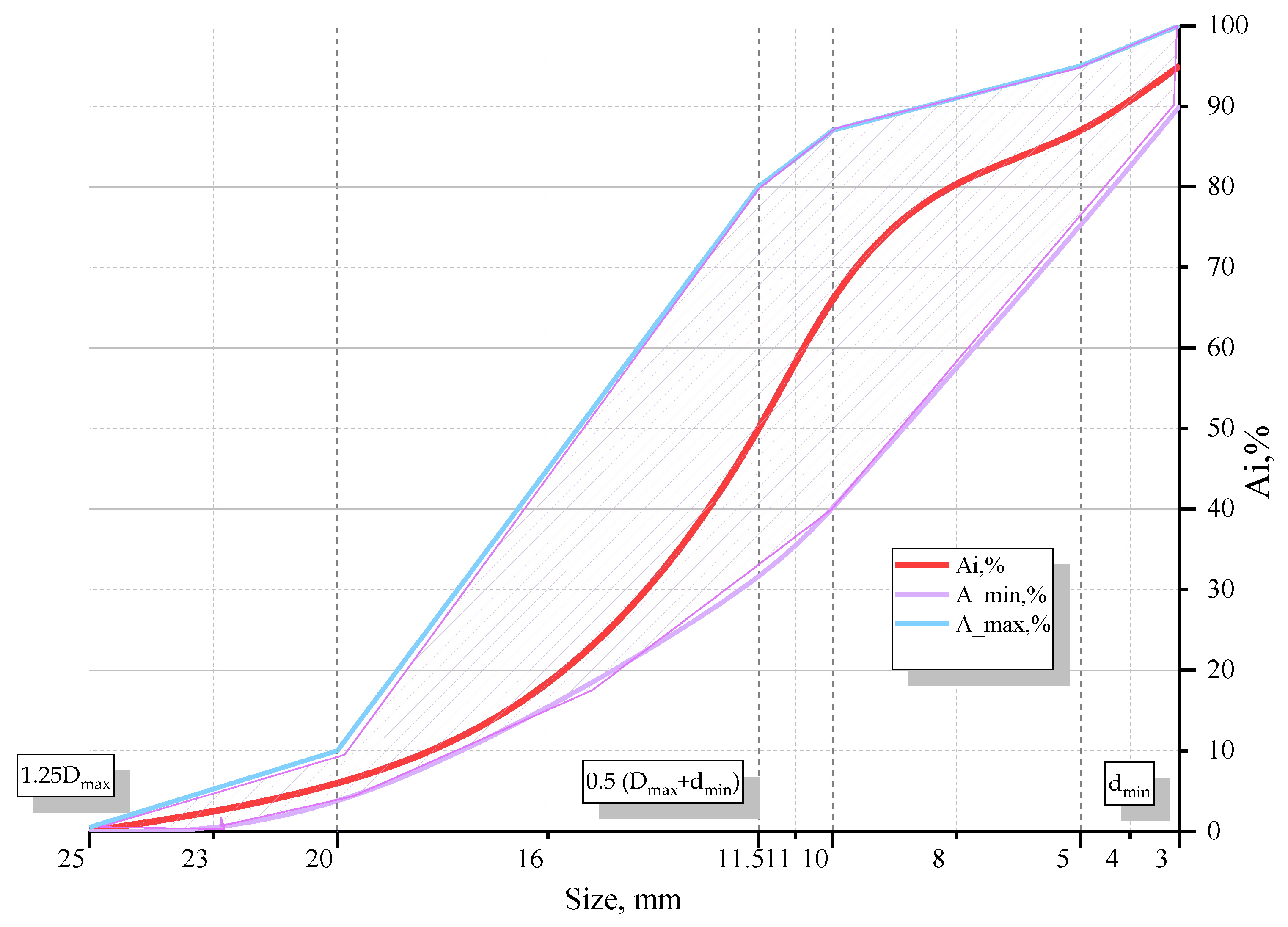
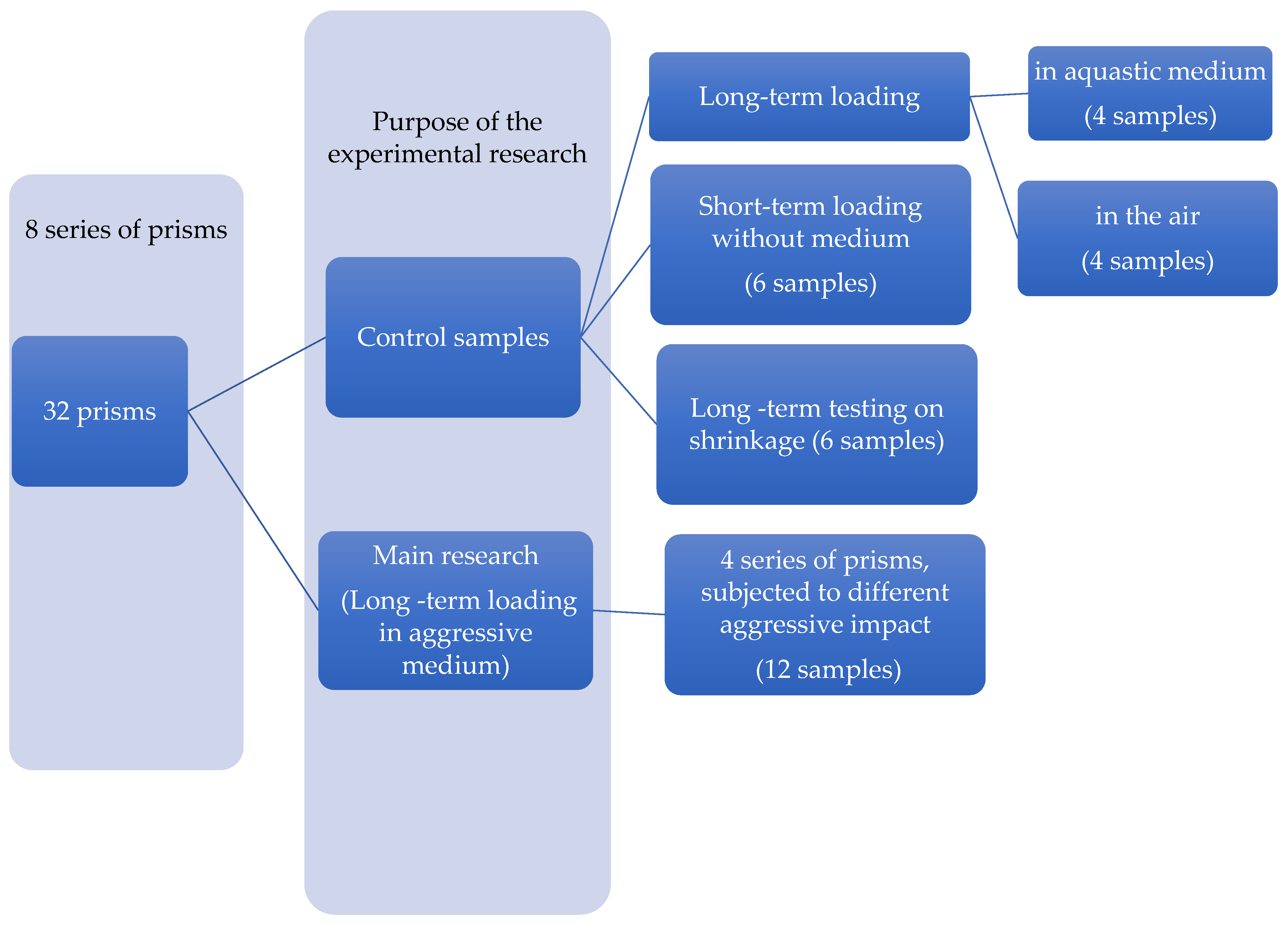
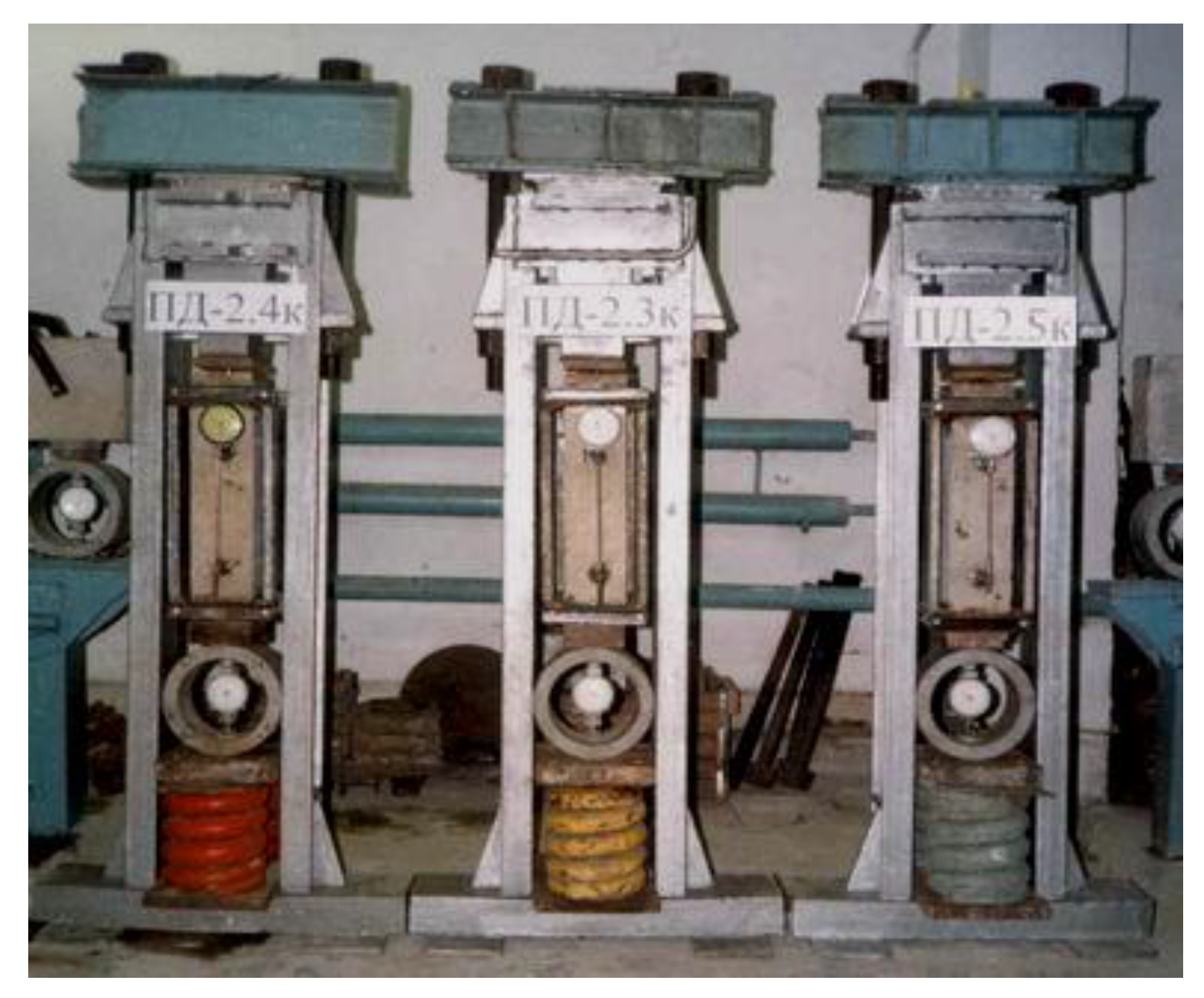
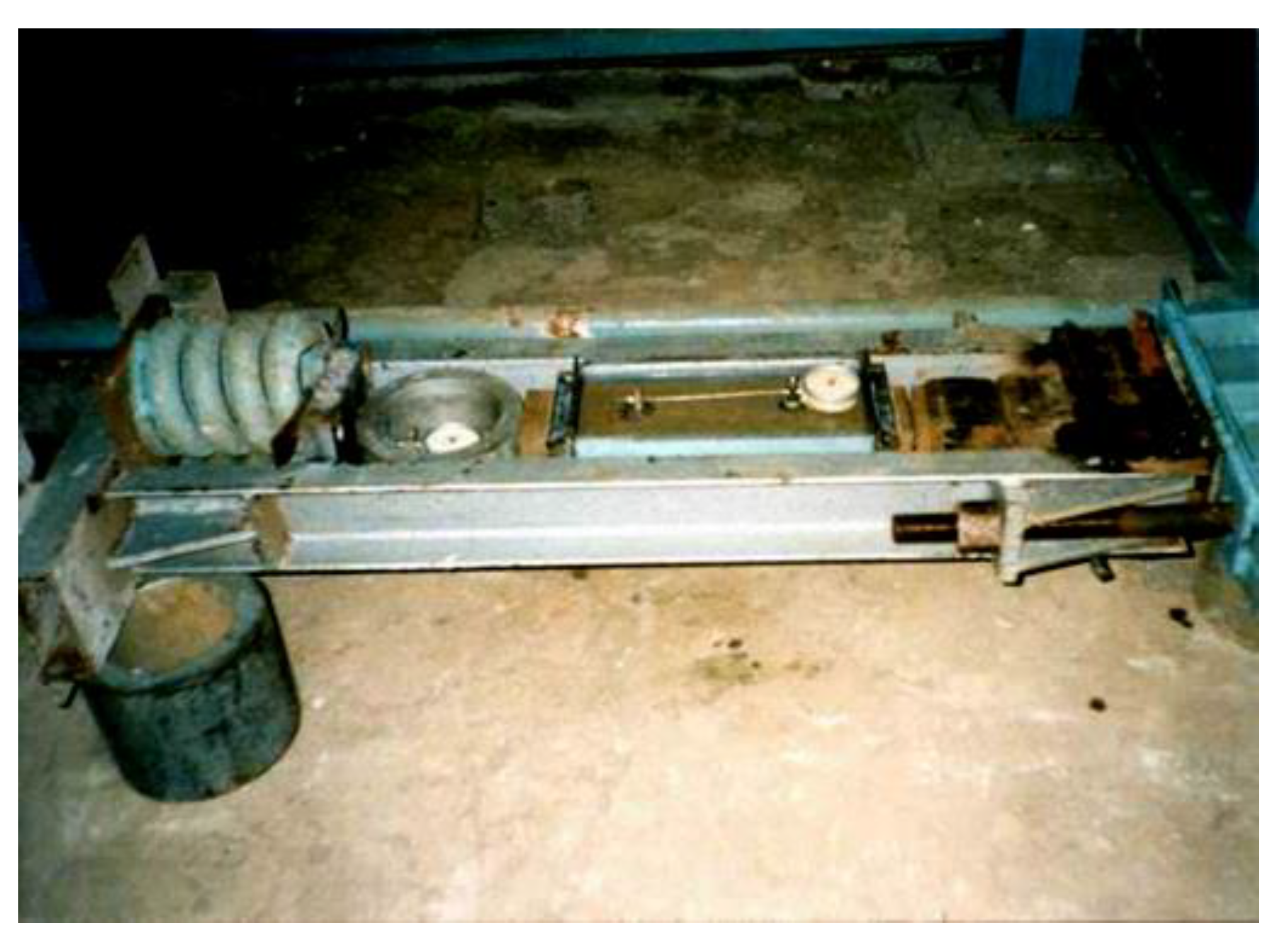
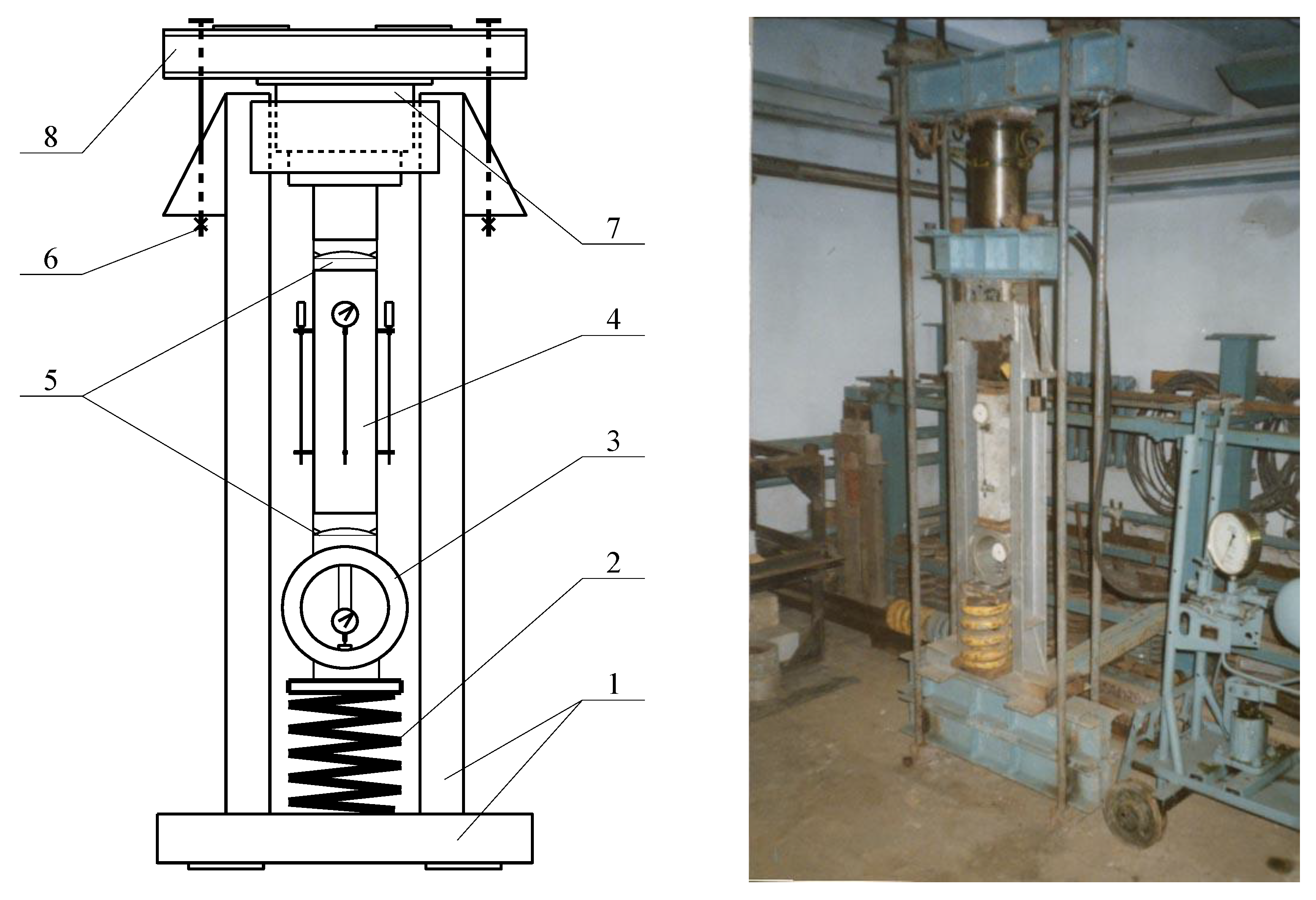
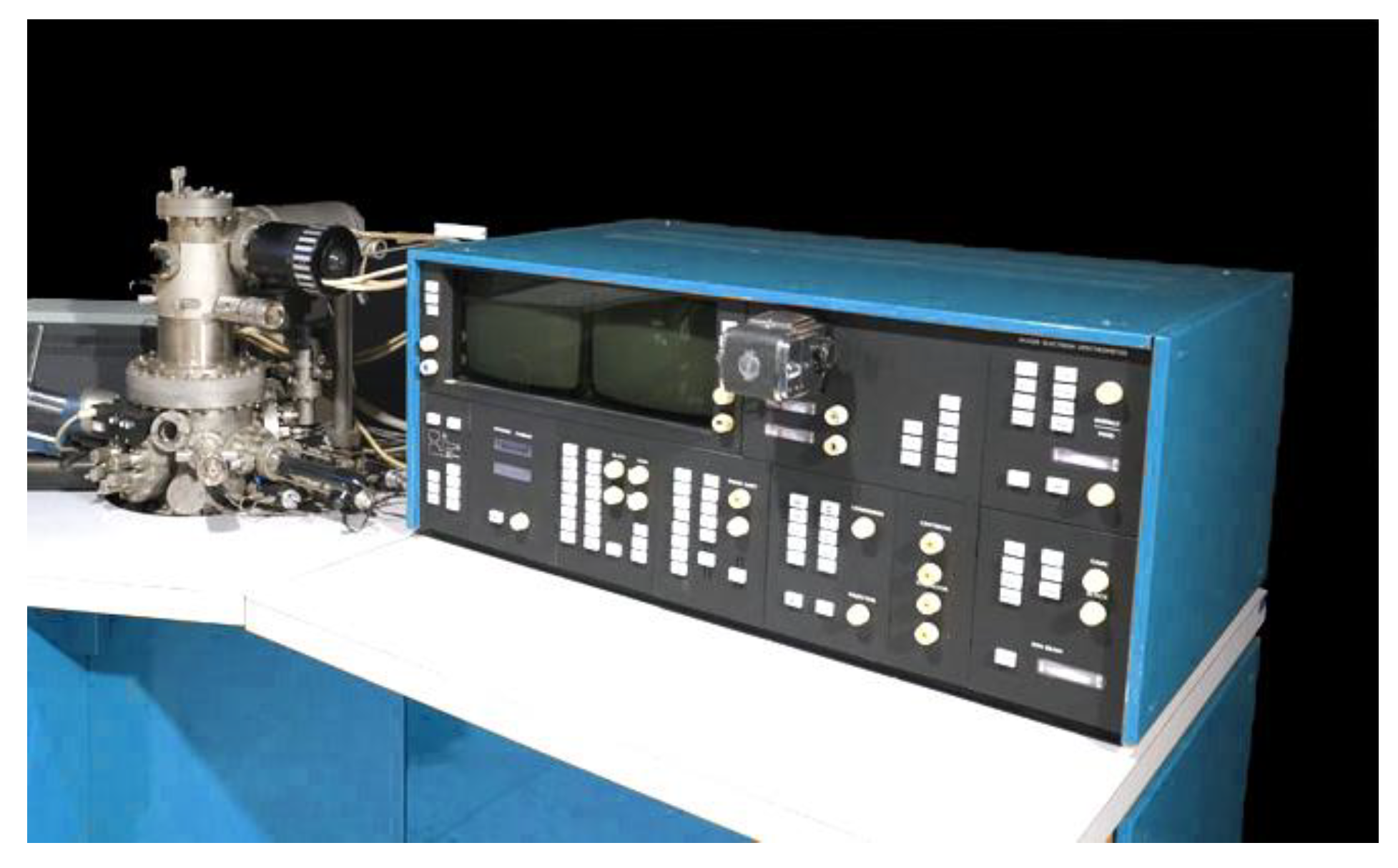

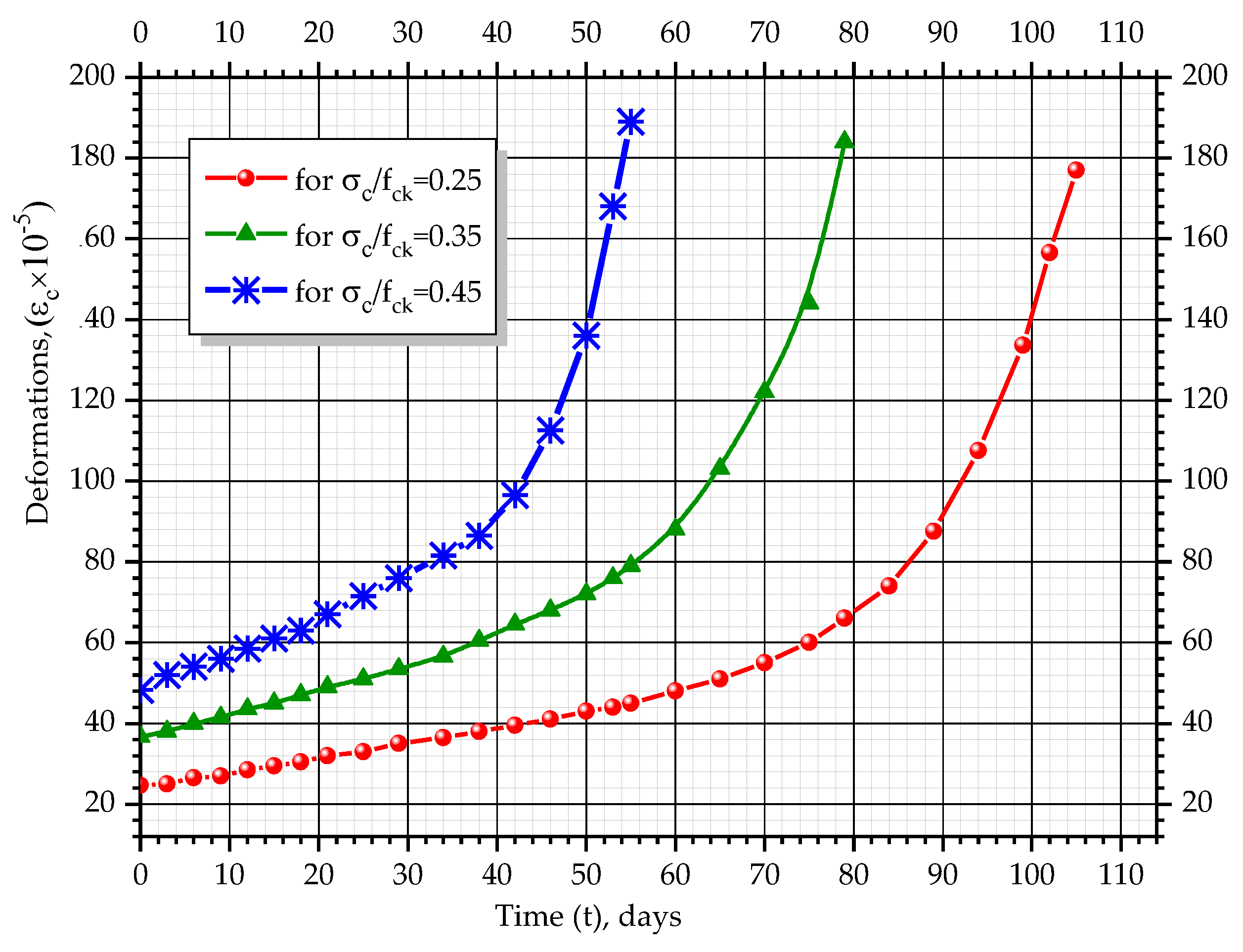
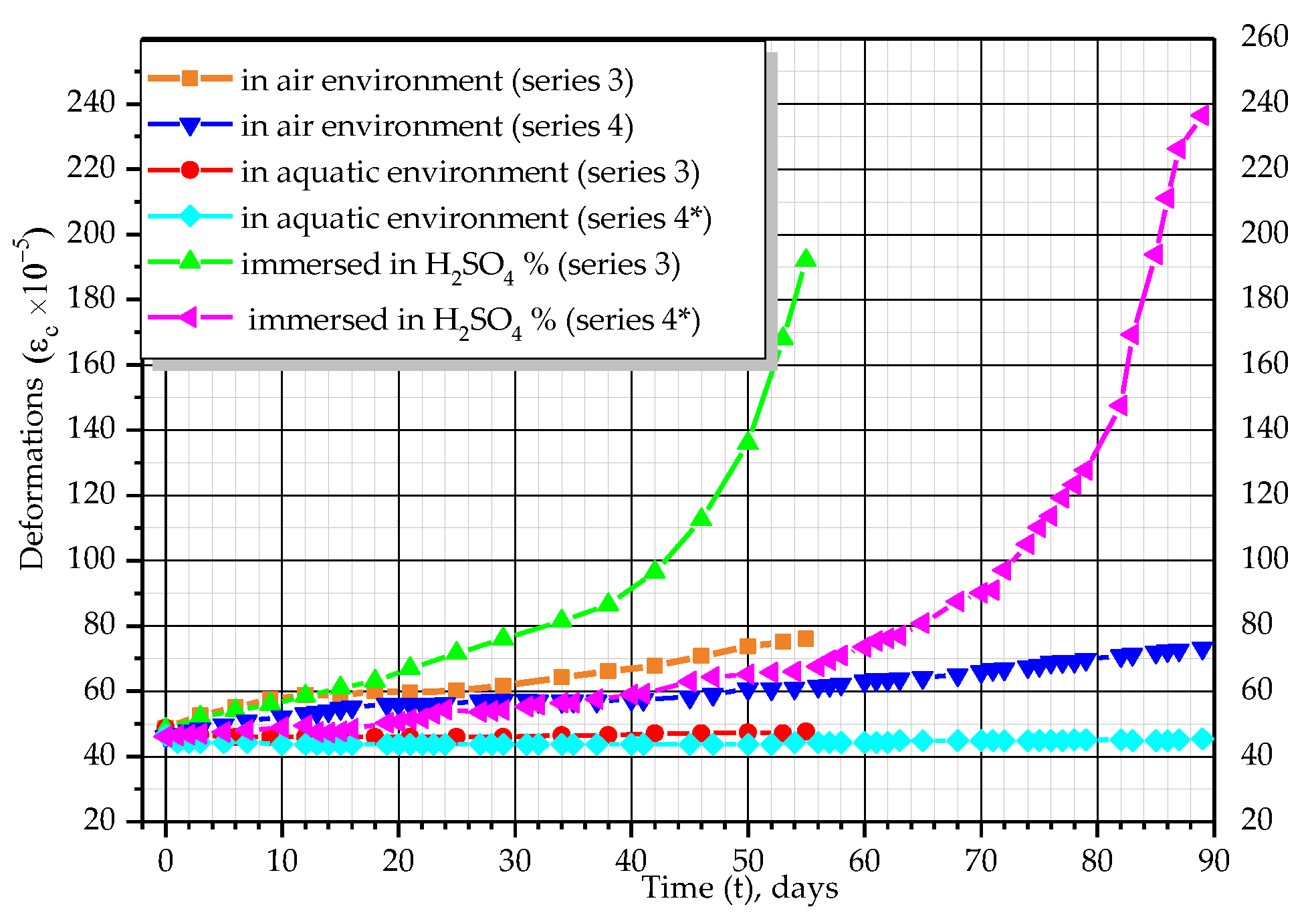
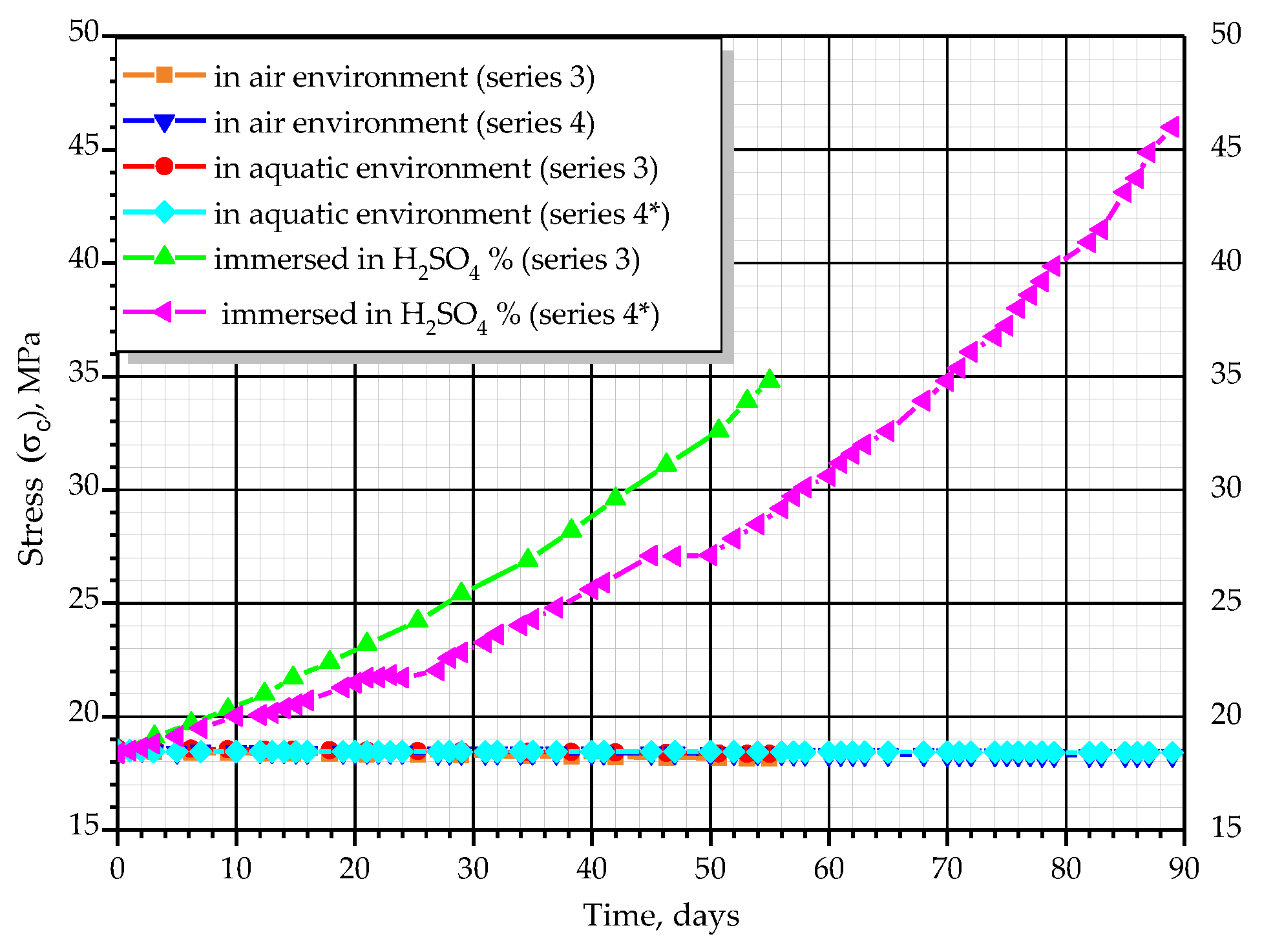

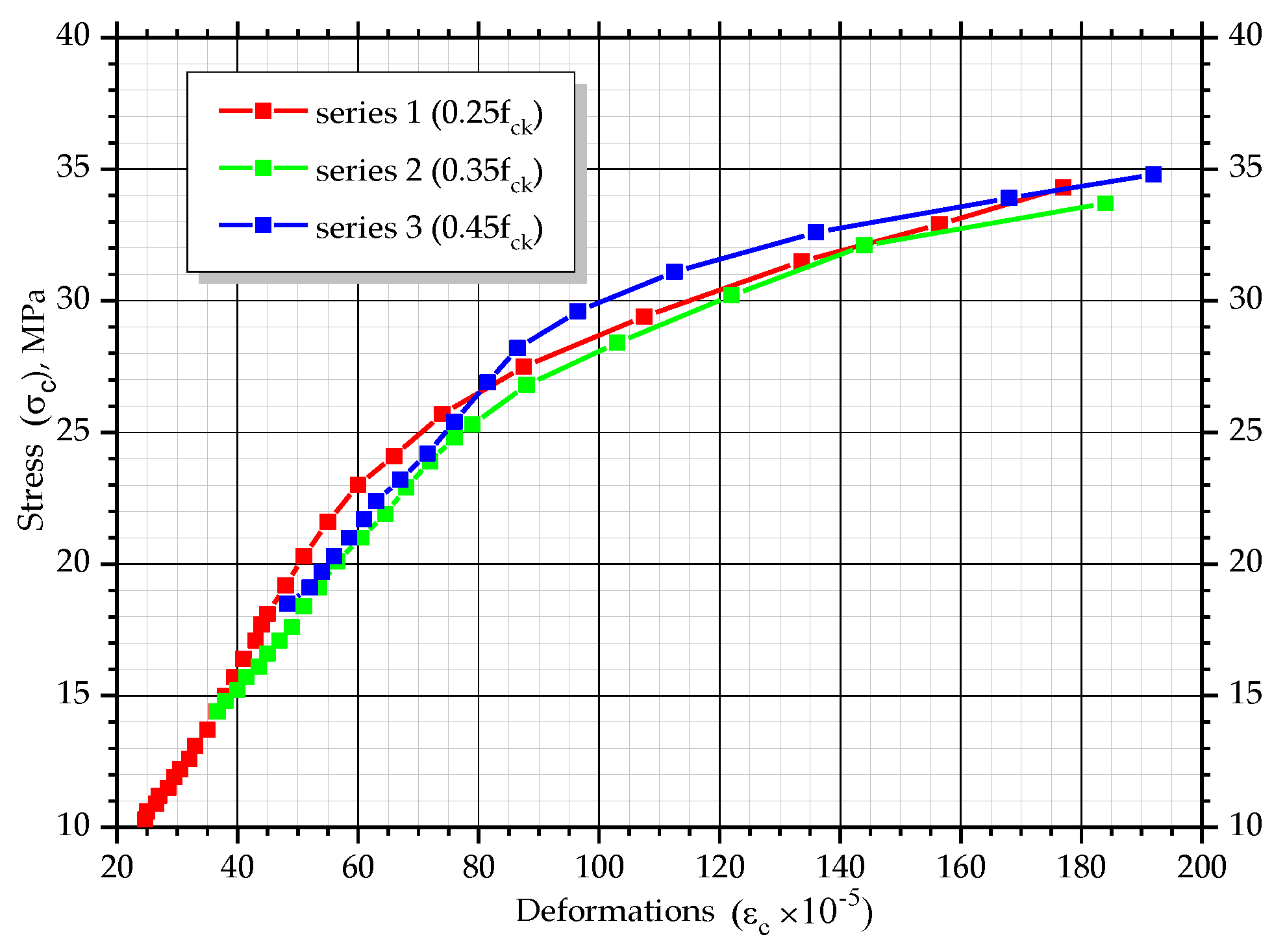

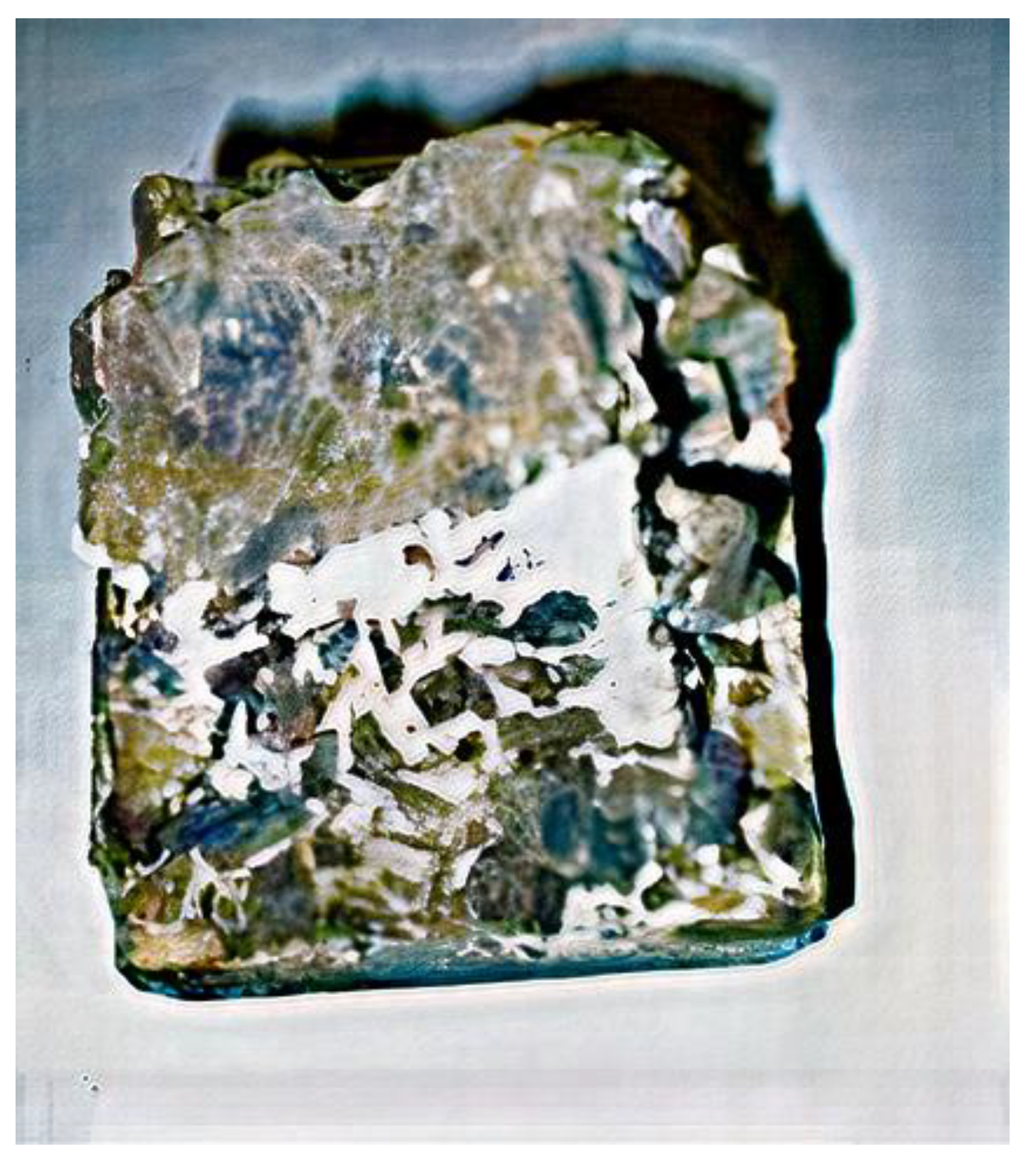


| Component | Amount, kg/m3 | % of Mass |
|---|---|---|
| Cement | 500 | 21.6 |
| Quartz sand | 505 | 21.9 |
| Granite crushed stone | 1135 | 49.2 |
| Water | 160 | 6.9 |
| Super-plasticizer “Chrysofluid” | 6 | 0.26 |
| Air-absorbing additive “Chrysoair” | 0.17 | 0.01 |
| Characteristics | M400 Grade | M500 Grade |
|---|---|---|
| Marking according to DSTU BV 2.7–46: 2010 | CEM I 32.5 N | CEM I 42.5 N |
| The material composition of cement by weight, % | Portland cement clinker 100% | |
| Specific gravity, g/cc | 3.11 | 3.15 |
| Compressive strength, MPa | ||
| 2nd day | 26.0 | 36.0 |
| 28th day | 48.0 | 56.0 |
| Setting time, minutes | ||
| initial | 160 | 140 |
| final | 240 | 220 |
| Fineness of Cement, % | 7.3 | 8.5 |
| Series | Marking | Concrete Strength, fck, MPa | Residual Cross-Sectional Area, S, cm2 | Flexibility, λ | γm | Ultimate Load, Nult, kN | Difference, % | |
|---|---|---|---|---|---|---|---|---|
| Theoretical (Eurocode 2) | Experimental | |||||||
| Series 1 | PL-1.1c | 41.0 | 37.8 | 6.5 | 0.92 | 126.5 | 104.6 | 17.3% |
| PL-1.2c | 41.0 | 36.9 | 6.7 | 123.9 | 104.3 | 15.6% | ||
| PL-1.3c | 41.0 | 35.5 | 6.8 | 118.7 | 103.5 | 12.8% | ||
| Series 2 | PL-2.1c | 41.0 | 54.8 | 5.4 | 185.3 | 149.3 | 19.4% | |
| PL-2.2c | 41.0 | 51.3 | 5.6 | 171.7 | 147.8 | 13.9% | ||
| PL-2.3c | 41.0 | 53.3 | 5.5 | 178.3 | 143.5 | 19.5% | ||
| Series 3 | PL-3.1c | 41.0 | 67.0 | 4.9 | 226.7 | 188.2 | 17.0% | |
| PL-3.2c | 41.0 | 65.6 | 5.0 | 220.1 | 184.5 | 16.2% | ||
| PL-3.3c | 41.0 | 64.1 | 5.0 | 214.5 | 188.1 | 12.3% | ||
| Series 4 | PL-4.3c | 53.6 | 51.8 | 5.6 | 230.1 | 190.1 | 17.4% | |
| PL-4.4c | 53.6 | 49.0 | 5.7 | 217.5 | 191.0 | 12.2% | ||
| PL-4.5c | 53.6 | 51.1 | 5.6 | 226.9 | 190.5 | 16.4% | ||
| Series | Marking | Ratio Nult/S, kN/cm2 | Difference, % | Measurement Error | ||
|---|---|---|---|---|---|---|
| Theoretical | Experimental | Instrumental | Total, % | |||
| Series 1 | PL-1.1c | 3.35 | 2.77 | 17.3% | up to 2 divisions (2%) | 2.4% |
| PL-1.2c | 3.35 | 2.82 | 15.6% | 0.7% | ||
| PL-1.3c | 3.34 | 2.92 | 12.8% | 3% | ||
| Series 2 | PL-2.1c | 3.38 | 2.72 | 19.4% | 1.7% | |
| PL-2.2c | 3.35 | 2.88 | 13.9% | 4.2% | ||
| PL-2.3c | 3.35 | 2.69 | 19.5% | 2.7% | ||
| Series 3 | PL-3.1c | 3.38 | 2.81 | 17.0% | 1.4% | |
| PL-3.2c | 3.36 | 2.81 | 16.2% | 1.4% | ||
| PL-3.3c | 3.35 | 2.93 | 12.3% | 2.8% | ||
| Series 4 | PL-4.3c | 4.44 | 3.67 | 17.4% | 2.5% | |
| PL-4.4c | 4.44 | 3.89 | 12.2% | 3.4% | ||
| PL-4.5c | 4.44 | 3.73 | 16.4% | 1% | ||
Publisher’s Note: MDPI stays neutral with regard to jurisdictional claims in published maps and institutional affiliations. |
© 2021 by the authors. Licensee MDPI, Basel, Switzerland. This article is an open access article distributed under the terms and conditions of the Creative Commons Attribution (CC BY) license (https://creativecommons.org/licenses/by/4.0/).
Share and Cite
Blikharskyy, Y.; Selejdak, J.; Kopiika, N.; Vashkevych, R. Study of Concrete under Combined Action of Aggressive Environment and Long-Term Loading. Materials 2021, 14, 6612. https://doi.org/10.3390/ma14216612
Blikharskyy Y, Selejdak J, Kopiika N, Vashkevych R. Study of Concrete under Combined Action of Aggressive Environment and Long-Term Loading. Materials. 2021; 14(21):6612. https://doi.org/10.3390/ma14216612
Chicago/Turabian StyleBlikharskyy, Yaroslav, Jacek Selejdak, Nadiia Kopiika, and Rostyslav Vashkevych. 2021. "Study of Concrete under Combined Action of Aggressive Environment and Long-Term Loading" Materials 14, no. 21: 6612. https://doi.org/10.3390/ma14216612
APA StyleBlikharskyy, Y., Selejdak, J., Kopiika, N., & Vashkevych, R. (2021). Study of Concrete under Combined Action of Aggressive Environment and Long-Term Loading. Materials, 14(21), 6612. https://doi.org/10.3390/ma14216612






